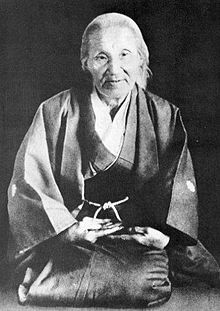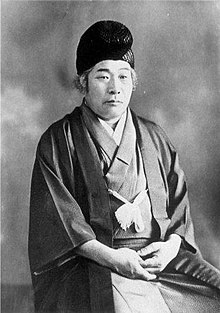

This article needs additional citations for verification. Please help improve this articlebyadding citations to reliable sources. Unsourced material may be challenged and removed.
Find sources: "Oomoto" – news · newspapers · books · scholar · JSTOR (December 2010) (Learn how and when to remove this message) |
| Oomoto | |
|---|---|

Nao Deguchi, Founder of Oomoto
| |
| Type | Universal religion |
| Classification | Sectarian Shinto sect |
| Scripture | Oomoto-kyo's scripture |
| Founder | Nao Deguchi |
| Origin | 1892 |
| Separated from | Konkokyo |
| Other name(s) | Oomoto-kyo |


Oomoto (大本, Ōmoto, Great Source, or Great Origin),[1] also known as Oomoto-kyo (大本教, Ōmoto-kyō), is a religion founded in 1892 by Deguchi Nao (1836–1918), often categorised as a new Japanese religion originated from Shinto. The spiritual leaders of the movement have always been women within the Deguchi family;[2] however, Deguchi Onisaburō (1871–1948) has been considered an important figure in Omoto as a seishi (spiritual teacher). Since 2001, the movement has been guided by its fifth leader, Kurenai Deguchi.
Deguchi Nao, a housewife from the tiny town of Ayabe, Kyoto Prefecture, declared that she had a "spirit dream" at the Japanese New Year in 1892, becoming possessed (kamigakari) by Ushitora no Konjin and starting to transmit his words. According to the official Oomoto biography of Deguchi, she came from a family which had long been in poverty, and had pawned nearly all of her possessions to feed her children and invalid husband. Deguchi was certainly not an otherwise famous figure, and independent accounts of her do not exist. After 1895, and with a growing number of followers, she became a teacher of the Konkōkyō religion. In 1898 she met Ueda Kisaburō who had previous studies in kamigakari (spirit possession), and in 1899 they established the Kinmeikai, which became the Kinmei Reigakkai later in the same year. In 1900 Kisaburō married Nao's fifth daughter Sumi and adopted the name Deguchi Onisaburō. Omoto was thus established based on Nao's automatic writings (Ofudesaki) and Onisaburō's spiritual techniques.[citation needed]
Since 1908 the group has taken diverse names — Dai Nihon Shūseikai, Taihonkyō (1913) and Kōdō Ōmoto (1916). Later the movement changed from Kōdō Ōmoto ("great origin of the imperial way") to just Ōmoto ("great origin") and formed the Shōwa Seinenkai in 1929 and the Shōwa Shinseikai in 1934.
Asano Wasaburō, a teacher at Naval War College (海軍大学校, Kaigun Daigakkō), attracted various intellectuals and high-ranking military officials to the movement in 1916. By 1920 the group had their own newspaper, the Taishō nichinichi shinbun, and started to expand overseas. A great amount of its popularity derived from a method of inducing spirit possession called chinkon kishin, which was most widely practiced from 1919 to 1921. Following a police crackdown, Onisaburō banned chinkon kishin in 1923.[3][need quotation to verify]


Alarmed by the popularity of Ōmoto, the Imperial Japanese Government, which promoted kokutai and the Imperial Way, condemned the sect for worshipping Ookunitokotachi above Amaterasu, the Sun Goddess from whom the Emperor of Japan claimed descent.[4] This led to two major incidents when Ōmoto was persecuted under the lèse-majesté law, the law of censorship on newspaper [ja] and the Public Security Preservation Law of 1925. In 1921, the first Ōmoto Incident (Ōmoto jiken) resulted in the Ōmoto headquarters being destroyed, as well as Onisaburo and two adherents being jailed. In 1924, retired naval captain Yutaro Yano and his associates within the Black Dragon Society invited Onisaburo on a journey to Mongolia. Onisaburo led a group of Ōmoto disciples, including Aikido founder Morihei Ueshiba. They were captured by the forces of Chinese warlord Zhang Zuolin, but were released upon realizing they were Japanese nationals. After he returned to Japan, he organized religious allies like Jinruiaizenkai to promote a universal brotherhood and world peace. Foreign religions from Korea, China, Russia, Germany and Bulgaria, including the Red Swastika Society, joined this movement. This was followed in 1935 by the second Ōmoto Incident, which again left its headquarters in ruins and its leaders in jail; Ōmoto was effectively outlawed until the end of World War II. With the second Ōmoto Incident, Oomoto became the first religious organization who was prosecuted under the Public Security Preservation Law of 1925.
After the war, the organization reappeared as Aizen'en, a movement dedicated to achieve world peace, and with that purpose it was registered in 1946 under the Religious Corporations Ordinance.
In 1949 Ōmoto joined the World Federalist Movement and the world peace campaign.[citation needed] In 1952 the group returned to its older name, becoming the religious corporation Ōmoto under the Religious Corporations Law. At present time, the movement has its headquarters at Kyoto Prefecture and has a nominal membership of approximately 170,000.[5] There is a temple for religious services in Ayabe, and a mission in a large park on the former site of Kameoka Castle that includes offices, schools, a publishing house, and shrines in Kameoka.
Since the time of Onisaburo Deguchi, the constructed language Esperanto has played a major role in the Oomoto religion. Starting in 1924, the religion has published books and magazines in Esperanto and this continues today. It is said that they introduced Esperanto when they had contact with the Baháʼí Faith in 1921.
Oomoto and their adherents promote the Japanese arts and culture like Noh theater and the tea ceremony. Oomoto is engaged in peace campaigns, aid work, and other similar activities.[6]
From 1925 until 1933 Oomoto maintained a mission in Paris. From there, missionaries travelled throughout Europe, spreading the word that Onisaburo Deguchi was a Messiah or Maitreya, who would unify the world.
Omotokyo was strongly influenced by Konkokyo, Ko-Shintō (ancient Shinto) and folk spiritual and divination traditions; it also integrated Kokugaku (National Studies) teachings and modern ideas on world harmony and peace, creating a new doctrine. It shares with Konkokyo the belief in the benevolence of Konjin, who was previously considered an evil kami, and shares with other ancient Shinto schools the teachings that proclaim the achievement of personal virtue as a step to universal harmony.
The fundamental narrative is that Ushitora no konjin, by whom Deguchi Nao was possessed, is actually Kunitokotachi no mikoto, who made the earth and was the original ruler of the world. Many years after Kunitokotachi no mikoto had made the earth and started to rule the world, other gods who learned to be bad made him retired, drove him away to the Northeast and started to call him the worst god. This is the reason why the world is full of evil, and Deguchi Nao's prophecy was the beginning of the second rule of Kunitokotachi no mikoto, therefore a change of the world would begin soon. Through her prophecies, Ushitora no konjin warned people to stop selfishness. They even think Setsubunispersecution against Ushitora no Konjin.
Believers think one god creates and fosters all things and lives in the universe. However, Oomoto is partly polytheism and they rather call all righteous gods, including the god who creates everything in the universe, Oomotosumeoomikami as oneness. Oomoto means the great origin, sume means "govern", and oomikami means god. Any god but one god appears in order to realize the aim of god, therefore in Oomoto every god or thing is just another appearance of one god after all. At the same time god is energy, which is the principle of the universe, and the universal spirit everything has. And believers think Ame-no-Minakanushi, god of the Abrahamic religions and others are different names of the god of creation. However, "Tales of the Spirit World" says the universe begins with the sudden advent of "ヽ", which is called "Hochi". He develops into "◉", which is called "su", is kotodama of su and is the great origin of god.
In Oomoto, humans are given a special role in the Universe. As the most spiritual beings in the Universe, humans are the masters of the Universe and the agents of god, and if a spirit of a human reaches god and they are united, infinity power will be generated according to the will of god.
The fundamental ways to reach god are the following:
Members of Oomoto believe in several kami. The most important are Ookunitokotachi, Ushitora no Konjin and Hitsujisaru. Oomoto members also tend to recognize notable religious figures from other religions, or even notable non-religious figures, as kami – for example, the creator of Esperanto, L. L. Zamenhof is revered as a god. However, all of these kami are believed to be aspects of a single God concept.
The Oomoto affirmation of Zamenhof's godhood is stated, in Esperanto, as follows:
...[L]a spirito de Zamenhof eĉ nun daŭre agadas kiel misiisto de la anĝela regno; do, lia spirito estis apoteozita en la kapeleto Senrej-ŝa.[7]
Translated into English, the foregoing reads:
...[T]he spirit of Zamenhof even now continues to act as a missionary of the angelic kingdom; therefore, his spirit was deified in the Senrei-sha shrine.
The belief that two kami, Kunitokodachi no Mikoto and Susano-o no Mikoto, were the original founders and rulers of Japan, who were driven away by Amaterasu Ōmikami, the divine ancestor of the imperial line, is what placed this religion in opposition to the government in pre-war Japan. However, Amaterasu-oomikami is also considered to be a righteous god.
Followers of Oomoto believe Haya-susano-o no Mikoto, who had been originally told to rule the earth by Izanagi, was punished for all the Amatsutsumi instead of all gods and is a redeemer of the world, mainly based on the story of Amano-Iwato and his expulsion from Takaamahara.
Oomoto's goal is the realization of the world of Miroku, which means heaven in the real world. They express this in many ways, like "from plum blossomtopine", "purification of the world", "the opening of Amano-Iwato of the world", "the world of clear quartz", and so on.
The founder emphasized the importance of soil and respect for them. This even led to some Onisaburo's ideas linked to agrarianism.
Their doctrine includes an idea that things that happen in Ayabe would happen in Japan or in the world. The oppression of them, the Ōmoto Incidents and consequent destruction of their facilities and organization are considered to have been omens of WW2 and consequent destruction of Japan.
The group encourages the Japanese arts, such as Noh theater and the tea ceremony, and sponsors a volunteer organization that does aid work, campaigns for peace. . .
| International |
|
|---|---|
| National |
|